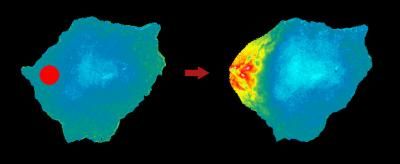Lowering pH regulates spider’s silk production
Advertisement
How can a tiny spider body contain material for several decimeters of gossamer silk, and what governs the conversion to thread? Researchers at the Swedish University of Agricultural Sciences (SLU) can now explain this. The new research findings are presented in Nature.
“We have seen how the first part of the spider silk protein has a very special and important function. It quite simply controls when the protein is to be converted into gossamer,” says My Hedhammar, one of the researchers at SLU.
By rapidly lowering the pH, a spider can initiate the conversion to silk. Before this, the protein needed to form the silk is stored in a gland in the spider’s body.
When it is time to spin a thread, the protein passes through a canal where it is converted to gossamer. Along the canal, the conditions change: among other things, the pH is lowered from a neutral (pH 7) to a somewhat more acidic level, pH 6.
“The spider gossamer protein consists of three parts. At SLU, this time we have primarily studied the first part, named NT, and have seen that it has very special properties that are important to the spider. At neutral pH, NT helps the protein to remain in liquid form. When the pH goes down, NT sees to it that threads are formed rapidly and also in an orderly manner,” says My Hedhammar.
It has long been a dream of researchers to be able to produce artificial spider silk, since it is one of the strongest materials known. There are therefore great hopes about what spider gossamer could be used for in the future, everything from surgical sutures to bullet-proof vests.
Spider silk is a strong and elastic material, and it is moreover biodegradable. It could be of great importance in medical technology, for example. To be able to produce artificial gossamer, basic research about how spiders go about it is a key piece of the puzzle.
Numerous researchers around the world are trying to map this process. At SLU several scientists are involved in this work, which is largely done with classical biochemical methods.
These researchers have primarily conducted their studies using the spider Euprosthenops australis, a species that makes one of the strongest threads and that is moreover large enough to be dissected in a simple way. But the new findings about gossamer protein seems to apply to all spider silk, regardless of species.



















































